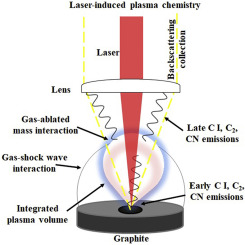当前位置:
X-MOL 学术
›
Spectrochim. Acta B. At. Spectrosc.
›
论文详情
Our official English website, www.x-mol.net, welcomes your
feedback! (Note: you will need to create a separate account there.)
Plasma chemistry produced during laser ablation of graphite in air, argon, helium and nitrogen
Spectrochimica Acta Part B: Atomic Spectroscopy ( IF 3.2 ) Pub Date : 2020-04-01 , DOI: 10.1016/j.sab.2020.105800 Daniel Diaz , David W. Hahn
Spectrochimica Acta Part B: Atomic Spectroscopy ( IF 3.2 ) Pub Date : 2020-04-01 , DOI: 10.1016/j.sab.2020.105800 Daniel Diaz , David W. Hahn

|
Abstract Laser-induced plasma chemistry produced during the ablation of graphite targets at atmospheric pressure in air, argon, helium and nitrogen was studied through time-resolved atomic and molecular emission spectroscopy. The plasma plume and plasma chemistry were generated by focusing a 6-mm diameter, 212 mJ, 1064-nm nanosecond Nd:YAG laser to a spot size of about 1 mm diameter over graphite samples of 99.9% pureness. The atomic emissions C I 247.86 nm, N I 821.50 nm and O I 777.19 nm, and the molecular bands C2 (473.71 nm) and CN (359.04 nm and 388.30 nm) were monitored as a function of time (0.2 to 220 μs). While the C I and C2 emissions followed a near-exponential decay, the CN emission in air and nitrogen showed an emission behavior characterized by two local maxima at 0.2 μs and 20–30 μs after the plasma ignition. The first maximum was explained by the early plasma chemistry produced by the ablated carbon species and the confining background gas, whereas the second maximum was attributed to atomic recombination and shock wave-induced excitation of the plasma plume. Two main effects were observed when the ablation was produced in different background gases. First, the presence of oxygen (≈21%) in air had a negligible effect on atomic lines; however, the CN emission intensity and lifetime were significantly reduced in comparison with an atmosphere of 100% nitrogen. This was attributed to the reduction of nitrogen species as reaction partners during the plasma chemistry in air. Secondly, due to the assumed higher plasma temperature in Ar, this gas favored the emission intensity and lifetime of atomic species but hindered the formation of C2 species. Because the collection optics of the emission spectroscopy system was configured in backscatter mode, which integrates over the entire plasma volume and gate time without spatial resolution, the time-resolved behavior of the plasma emissions were only related to the number density of emitters but not to specific locations in the plasma volume.
中文翻译:

在空气、氩气、氦气和氮气中激光烧蚀石墨时产生的等离子体化学
摘要 通过时间分辨原子和分子发射光谱研究了在大气压力下在空气、氩气、氦气和氮气中烧蚀石墨靶时产生的激光诱导等离子体化学。通过在纯度为 99.9% 的石墨样品上将 6 毫米直径、212 毫焦、1064 纳米纳秒 Nd:YAG 激光聚焦到约 1 毫米直径的光斑尺寸,产生等离子体羽流和等离子体化学物质。原子发射 CI 247.86 nm、NI 821.50 nm 和 OI 777.19 nm,以及分子带 C2(473.71 nm)和 CN(359.04 nm 和 388.30 nm)作为时间(0.2 至 220 μs)的函数进行监测。虽然 CI 和 C2 排放遵循近指数衰减,但空气和氮气中的 CN 排放表现出发射行为,其特征在于等离子体点火后 0.2 μs 和 20-30 μs 处的两个局部最大值。第一个最大值是由烧蚀的碳物质和封闭的背景气体产生的早期等离子体化学作用解释的,而第二个最大值归因于等离子体羽流的原子复合和冲击波诱导激发。当在不同的背景气体中产生烧蚀时,观察到两个主要影响。首先,空气中的氧气 (≈21%) 对原子线的影响可以忽略不计;然而,与 100% 氮气氛相比,CN 发射强度和寿命显着降低。这归因于在空气中的等离子体化学过程中作为反应伙伴的氮物种的减少。其次,由于Ar中假定较高的等离子体温度,这种气体有利于原子物种的发射强度和寿命,但阻碍了C2物种的形成。
更新日期:2020-04-01
中文翻译:

在空气、氩气、氦气和氮气中激光烧蚀石墨时产生的等离子体化学
摘要 通过时间分辨原子和分子发射光谱研究了在大气压力下在空气、氩气、氦气和氮气中烧蚀石墨靶时产生的激光诱导等离子体化学。通过在纯度为 99.9% 的石墨样品上将 6 毫米直径、212 毫焦、1064 纳米纳秒 Nd:YAG 激光聚焦到约 1 毫米直径的光斑尺寸,产生等离子体羽流和等离子体化学物质。原子发射 CI 247.86 nm、NI 821.50 nm 和 OI 777.19 nm,以及分子带 C2(473.71 nm)和 CN(359.04 nm 和 388.30 nm)作为时间(0.2 至 220 μs)的函数进行监测。虽然 CI 和 C2 排放遵循近指数衰减,但空气和氮气中的 CN 排放表现出发射行为,其特征在于等离子体点火后 0.2 μs 和 20-30 μs 处的两个局部最大值。第一个最大值是由烧蚀的碳物质和封闭的背景气体产生的早期等离子体化学作用解释的,而第二个最大值归因于等离子体羽流的原子复合和冲击波诱导激发。当在不同的背景气体中产生烧蚀时,观察到两个主要影响。首先,空气中的氧气 (≈21%) 对原子线的影响可以忽略不计;然而,与 100% 氮气氛相比,CN 发射强度和寿命显着降低。这归因于在空气中的等离子体化学过程中作为反应伙伴的氮物种的减少。其次,由于Ar中假定较高的等离子体温度,这种气体有利于原子物种的发射强度和寿命,但阻碍了C2物种的形成。











































 京公网安备 11010802027423号
京公网安备 11010802027423号